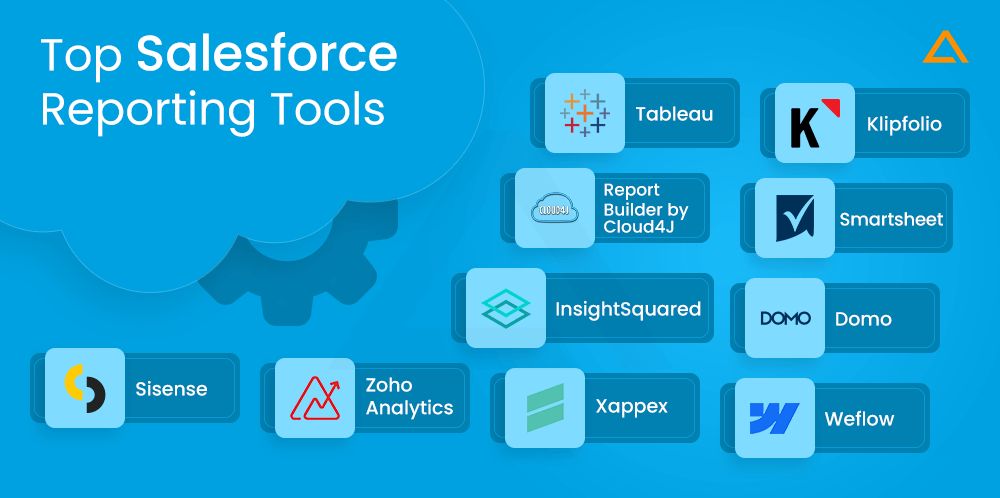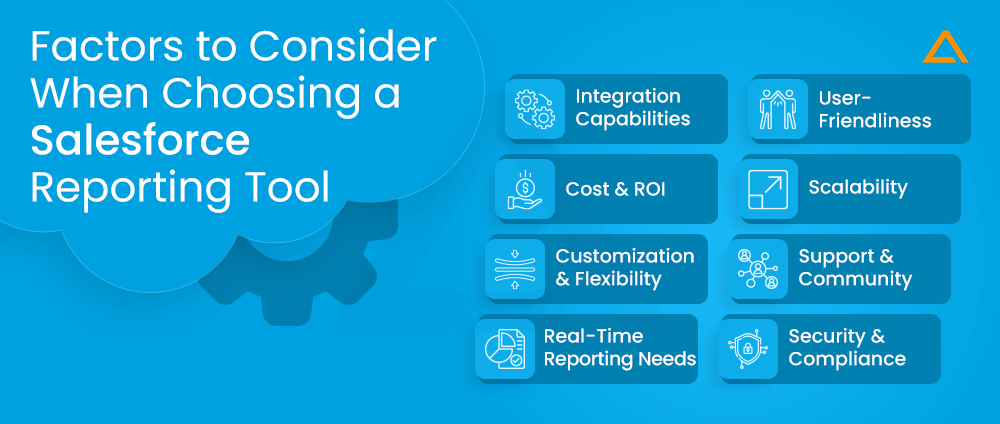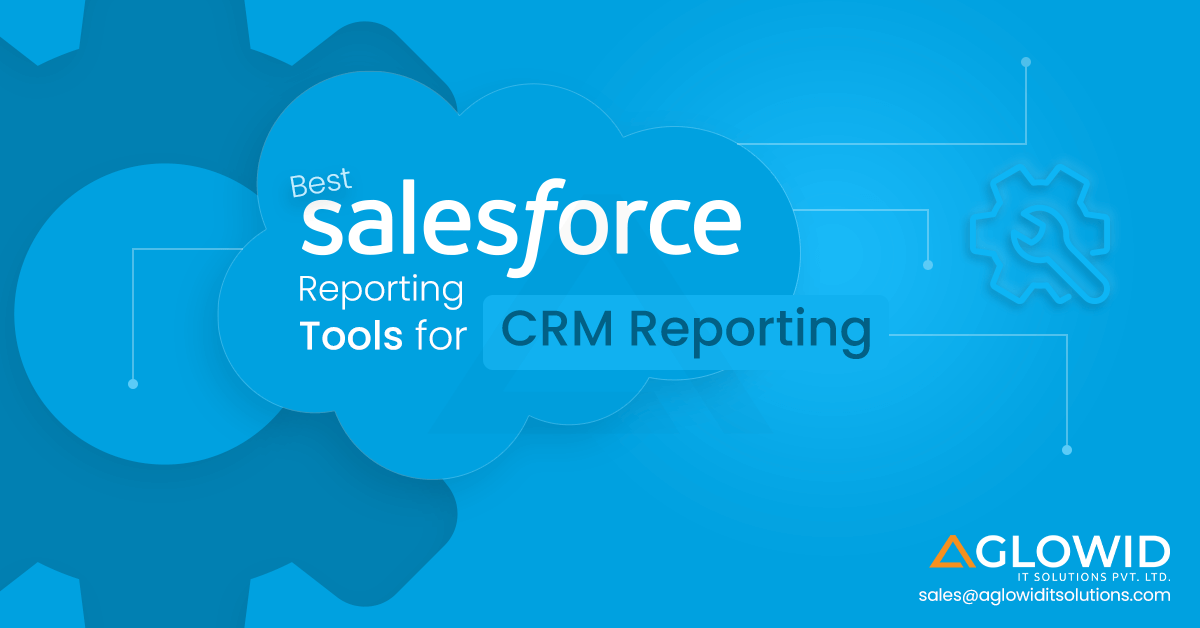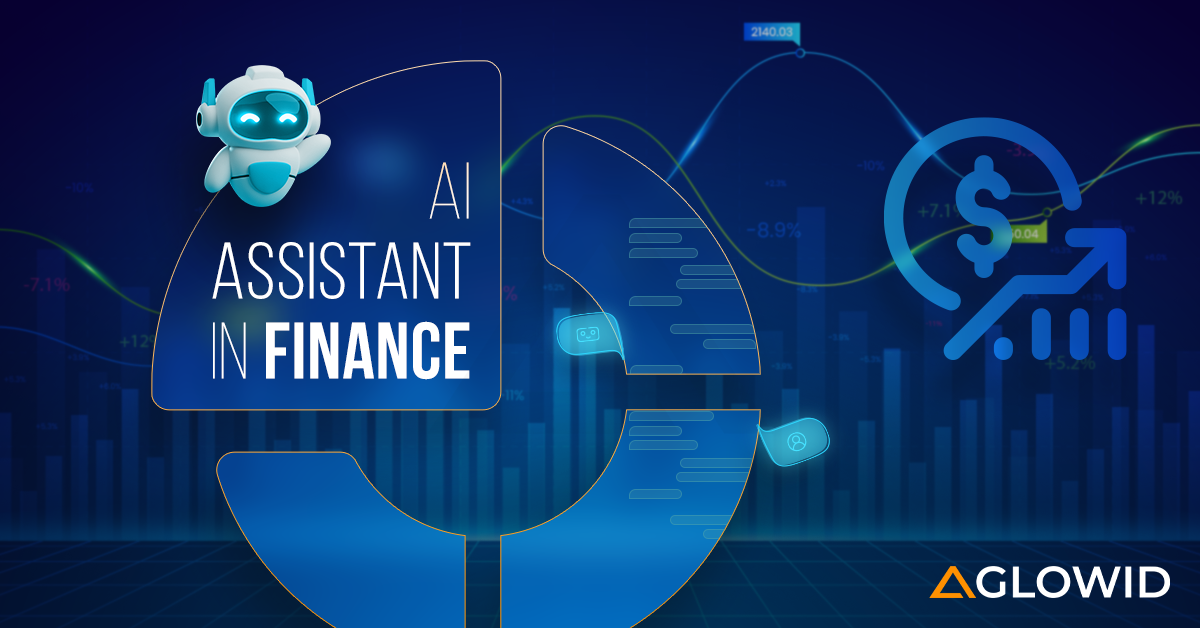Quick Summary:
Explore the top Salesforce reporting tools that go beyond the platform’s native capabilities. These advanced solutions offer real-time insights, customizable dashboards, and powerful data integration, ensuring your business gets the most out of its CRM analytics.
In this blog, we’re going to discuss📝
In the rapidly evolving business landscape, the ability to analyze data effectively and generate actionable insights is crucial for maintaining a competitive edge. Salesforce, one of the leading Customer Relationship Management (CRM) platforms, offers built-in reporting tools to help businesses track and analyze their performance.
However, as data requirements grow more complex, many organizations find these native tools insufficient for advanced analytics, real-time reporting, and cross-platform data integration.
This is where third-party Salesforce reporting tools come into play, providing the advanced features necessary to meet today’s demanding data processes. Whether you’re a small business looking to optimize your sales strategy or a large enterprise needing comprehensive data analysis, choosing the right Salesforce reporting tool is essential.
Common Questions we get asked about Salesforce Native Reporting Tool Capabilities Include:
- What are the limitations of Salesforce reporting?
- Why do Salesforce reports take so long?
- Is Salesforce CRM good or bad?
- What is the alternative to Salesforce CRM?
Today, we aim to clear the dust on this matter, and help C-level executives and decision makers like you get more clarity on the situation. Let’s begin by understanding the native Salesforce CRM Analytics capabilities:
Salesforce Reporting Tools: A Complete Overview
Salesforce offers a wide range of reporting tools, both native and third-party, that cater to various business needs. Whether you are looking for basic reporting capabilities or advanced analytics, there is a tool that can help you achieve your goals.
Understanding Salesforce’s Built-In Reporting Capabilities
Salesforce’s built-in reporting tools are designed to help businesses track, analyze, and visualize their data directly within the CRM platform. These tools offer a range of features that allow users to create standard reports, dashboards, and data visualizations to monitor key performance indicators (KPIs) and overall business performance.

Key Capabilities Include:
Custom Reports and Dashboards:
Users can create custom reports tailored to their specific needs and compile these into interactive dashboards. These dashboards provide a real-time overview of metrics such as sales performance, customer service statistics, and marketing campaign effectiveness.
Drag-and-Drop Interface:
The report builder offers a user-friendly, drag-and-drop interface, making it accessible for users without deep technical expertise. This interface allows users to select data fields, apply filters, and group data without needing to write complex queries.
Data Filtering and Grouping:
Salesforce reports allow users to filter data by various criteria (e.g., date ranges, customer segments) and group results to highlight trends and insights within the data. This makes it easier to focus on specific aspects of business operations.
Pre-Built Report Templates:
Salesforce provides a library of pre-built report templates that cover common business scenarios, helping users quickly generate reports without starting from scratch.
Integration with Other Salesforce Features:
Reports and dashboards seamlessly integrate with other Salesforce features, such as Sales Cloud and Service Cloud, providing a unified view of data across different business functions.
These built-in tools are powerful for standard reporting needs but may fall short in more complex scenarios, as highlighted in the subsequent limitations section.
Limitations of Salesforce’s Native Reporting Tools
Salesforce’s native reporting tools offer robust features for creating and managing reports within the platform. These tools allow users to access valuable insights, track key performance indicators (KPIs), and make data-driven decisions.
However, while Salesforce’s reporting tools are powerful, they also come with limitations that can impact more advanced reporting needs. These limitations may require businesses to explore third-party solutions or custom development to achieve their reporting goals.
Following are the limitations of Salesforce’s native reporting tools:

Limited Customization
While Salesforce offers a significant degree of customization, it still has limitations, particularly when dealing with advanced data manipulation and complex reporting needs.
For example, when creating reports that require multiple layers of data grouping or intricate calculations, Salesforce’s native tools may not provide the necessary flexibility. This can be frustrating for organizations that need highly customized reports to drive their strategic decisions.
Row Limitations
Salesforce imposes a limit on the number of rows that can be displayed in a report, which can be a major drawback for businesses dealing with large datasets.
According to Salesforce’s documentation, the maximum number of rows a report can display is 2,000, beyond which users must export the data to an external tool for further analysis. This limitation can be particularly challenging for companies that need to analyze large volumes of data directly within the Salesforce environment.
Limited Charting Options
When it comes to visualizing data, Salesforce’s native reporting tools offer a basic set of chart types. While these may suffice for simple reports, they fall short for users who require more advanced visualizations, such as heat maps, scatter plots, or complex multi-axis charts.
The inability to create these more sophisticated visualizations can limit a business’s ability to present data in a way that is most meaningful to stakeholders.
Complex Data Analysis
For businesses that require deep data analysis, Salesforce’s built-in tools may not be sufficient. The tools are designed for standard reporting and do not support more complex analytical functions such as predictive modeling or advanced statistical analysis.
Companies that need these capabilities often find themselves turning to third-party tools that offer a broader range of analytics features.
Limited Real-Time Reporting
Salesforce’s native reporting tools, while capable of delivering real-time updates, may not perform optimally when handling large datasets or integrating data from multiple sources.
This can result in delays and reduced accuracy in reporting, which can be detrimental to businesses that rely on up-to-the-minute data for decision-making.
Top Salesforce Reporting Tools in 2024
To fully leverage Salesforce for advanced data analysis and reporting, many businesses turn to third-party tools. These tools enhance Salesforce’s native capabilities by offering advanced analytics, customizable dashboards, and flexible reporting options. However, implementing these solutions and customizing them to fit your business needs often requires specialized expertise.
Let’s explore some of the top salesforce reporting tools:📝
This is where hiring a skilled Salesforce developer becomes crucial. An experienced developer can not only integrate third-party reporting tools but also optimize your Salesforce environment for better performance and tailored reporting solutions.
In this section, we’ll explore the top 10 Salesforce reporting tools of 2024, each designed to provide deeper insights and improve reporting efficiency, helping you make more informed decisions based on your CRM data.

Tableau + Salesforce – Put Smart Analytics in Your Salesforce CRM
Tableau is one of the most popular data visualization tools on the market, and its integration with Salesforce makes it a powerful reporting solution. This Salesforce reporting tool allows users to create interactive and shareable dashboards, providing deep insights into Salesforce data. Its drag-and-drop interface makes it easy to use, even for those without a technical background.
Tableau’s strength lies in its ability to handle large datasets and perform complex analyses, making it ideal for businesses that require detailed reporting.
Key Features:
- Advanced data visualization with customizable dashboards
- Seamless integration with Salesforce
- Ability to handle large datasets
- Drag-and-drop interface for ease of use
- Extensive library of visualization options
Pros:
- User-friendly interface
- Powerful analytics capabilities
- Strong community support
Cons:
- Can be expensive for smaller businesses
- Requires a learning curve for advanced features
Klipfolio – Succeed with Data
Klipfolio is another robust Salesforce reporting tool. It offers a highly customizable platform for creating dashboards and reports, allowing businesses to monitor key performance indicators (KPIs) in real-time.
Klipfolio’s ability to pull data from multiple sources and its powerful visualization capabilities make it a great choice for businesses looking to gain comprehensive insights.
Key Features:
- Real-time dashboards for tracking KPIs
- Customizable reports and dashboards
- Integration with multiple data sources, including Salesforce
- Extensive template library for quick setup
Pros:
- Real-time data updates
- Easy to customize
- Wide range of integration options
Cons:
- Can be complex to set up for beginners
- Limited offline capabilities
Report Builder by Cloud4J – Download & Schedule Existing Salesforce Reports & Dashboards in a Variety of Formats
Report Builder by Cloud4J is a tool designed to enhance Salesforce’s native reporting capabilities. It allows users to create complex reports that are not possible with Salesforce’s built-in tools. This tool is particularly useful for businesses that require detailed reporting and advanced data manipulation.
Key Features:
- Advanced report building capabilities
- Integration with Salesforce for seamless data access
- Customizable reports with advanced filtering options
- User-friendly interface
Pros:
- Enhances Salesforce’s native reporting
- User-friendly interface
- Supports complex data analysis
Cons:
- Limited to Salesforce data
- Can be complex for beginners
The Smartsheet – Accurate & Efficient Alignment Between Leadership, Sales, & Operations
The Smartsheet is a powerful project management and reporting tool for Salesforce. It provides enhanced reporting capabilities. It allows businesses to track and manage projects, tasks, and resources, all while generating detailed reports that can be shared with stakeholders.
Key Features:
- Project management and reporting in one platform
- Integration with Salesforce for real-time data access
- Customizable dashboards and reports
- Collaboration tools for team management
Pros:
- Combines project management and reporting
- Real-time data integration
- Easy to customize
Cons:
- Can be complex for non-technical users
- Requires training to fully utilize
InsightSquared – Powerful Sales Forecasting & Analytics
InsightSquared is a salesforce analytics and reporting tool that provides deep insights into sales performance. It offers advanced analytics, predictive forecasting, and customizable dashboards, making it a powerful tool for sales teams looking to optimize their performance.
Key Features:
- Sales analytics and reporting
- Predictive forecasting capabilities
- Customizable dashboards for sales tracking
- Integration with Salesforce for seamless data access
Pros:
- Powerful sales analytics
- Predictive forecasting
- User-friendly interface
Cons:
- Primarily focused on sales data
- Can be expensive for smaller teams
Domo – Get a Pre-Built Dashboard of Your Salesforce Data to Help you Convert More Leads & Close More Deals
Domo is a cloud-based business intelligence platform that integrates with Salesforce to provide comprehensive reporting and analytics capabilities. It offers a wide range of data visualization options, real-time dashboards, and the ability to pull data from multiple sources, making it a versatile tool for businesses of all sizes.
Key Features:
- Real-time dashboards and data visualization
- Integration with multiple data sources, including Salesforce
- Cloud-based platform for easy access
- Extensive library of pre-built connectors
Pros:
- Versatile and scalable
- Real-time data updates
- Easy to integrate with other tools
Cons:
- Can be expensive
- Requires training to fully utilize
Sisense – Agile CRM Management With Sisense BI & Salesforce
Sisense is a powerful business intelligence tool that integrates with Salesforce to provide advanced reporting and data analytics. It allows businesses to create interactive dashboards, perform complex data analysis, and share insights with stakeholders. Sisense’s strength lies in its ability to handle large datasets and perform real-time analytics.
Key Features:
- Advanced data analytics and visualization
- Real-time dashboards with customizable widgets
- Integration with Salesforce for seamless data access
- Scalable for businesses of all sizes
Pros:
- Handles large datasets effectively
- Real-time analytics
- Customizable and user-friendly
Cons:
- Can be complex for beginners
- Higher cost for advanced features
Zoho Analytics – Salesforce Advanced Analytics
Zoho Analytics is a self-service BI and data analytics software that allows users to create insightful reports and dashboards. It integrates seamlessly with Salesforce with its oho Analytics Advanced Analytics Connector for Salesforce CRM, enabling users to analyze their CRM data and derive actionable insights. Zoho Analytics is known for its user-friendly interface and extensive customization options.
Key Features:
- Self-service BI and data analytics
- Seamless integration with Salesforce
- Customizable dashboards and reports
- Drag-and-drop report builder
Pros:
- User-friendly and easy to use
- Extensive customization options
- Affordable pricing
Cons:
- Limited advanced analytics features
- May require additional tools for complex reporting
Xappex – G-Connector for Salesforce
Xappex’s G-Connector for Salesforce is a Google Sheets add-on that allows users to pull Salesforce data directly into Google Sheets. It enables users to create custom reports, dashboards, and analyses using Google Sheets, making it ideal for businesses that prefer working within the Google ecosystem.
Key Features:
- Integration with Google Sheets
- Customizable reports and dashboards
- Real-time data sync with Salesforce
- Easy to use for Google Sheets users
Pros:
- Simplifies Salesforce reporting for Google Sheets users
- Easy to set up and use
- Real-time data sync
Cons:
- Limited to Google Sheets users
- Lacks advanced analytics features
Weflow – The Sales Forecasting Tool to Ditch Your Spreadsheets
Weflow is a sales productivity platform that integrates with Salesforce to provide enhanced reporting and analytics capabilities. It allows sales teams to track performance metrics, monitor KPIs, and generate custom reports that can be shared with stakeholders. Weflow is known for its user-friendly interface and real-time data updates.
Key Features:
- Sales productivity and reporting platform
- Integration with Salesforce for real-time data access
- Customizable dashboards for tracking KPIs
- User-friendly interface
Pros:
- Enhances sales reporting in Salesforce
- Real-time data updates
- Easy to use and customize
Cons:
- Primarily focused on sales data
- Can be expensive for smaller teams
With so many tools available, choosing the right Salesforce reporting tool can be a daunting task. Below is a comparative analysis of some of the top tools based on their features, pricing, and user experience.
| Tool | Key Features | Pros | Cons | Best For |
| Tableau | Advanced analytics, data visualization, AI integration | Powerful, customizable, versatile | Expensive, complex for beginners | Large enterprises |
| Klipfolio | Real-time dashboards, data connectors, customization | Affordable, easy to use, real-time data | Limited advanced analytics features | Small to medium businesses |
| Report Builder by Cloud4J | Real-time reporting, Salesforce integration | Customizable, easy to use, real-time data | Limited advanced features | Small to medium businesses |
| The Smartsheet | Project management, Salesforce integration | Versatile, user-friendly, customizable | Limited to project management | Project-based teams |
| InsightSquared | Sales analytics, data visualization, Salesforce integration | Real-time data, easy to use, customizable | Limited to sales data, expensive | Sales teams |
| Domo | Business intelligence, real-time data, Salesforce integration | Advanced analytics, scalable, customizable | Expensive, complex for beginners | Large enterprises |
| Sisense | Data analytics, visualization, real-time reporting | Powerful, handles large datasets, customizable | Expensive, complex for beginners | Large enterprises |
| Zoho Analytics | Self-service BI, data analytics, Salesforce integration | Affordable, user-friendly, customizable | Limited advanced analytics features | Small to medium businesses |
| G-Connector for Salesforce | Google Sheets integration, real-time data | Easy to use, customizable, real-time data | Limited to Google Sheets users | Google Sheets users |
| Weflow | Sales productivity, real-time reporting, Salesforce integration | Enhances sales reporting, easy to use, customizable | Limited to sales data, expensive | Sales teams |

Looking to Hire Salesforce Developers?
Secure Project Success by Hiring a Salesforce Developer from Aglowid.
Factors to Consider When Choosing a Salesforce Reporting Tool
Choosing the right Salesforce reporting tool is critical for making the most out of your CRM data. Here’s a more in-depth look at the key factors to consider:
| Factor | Why It Matters | Top Salesforce Reporting Tools |
| Integration Capabilities | Ensures smooth data flow between systems, allowing comprehensive analysis and reporting. | Tableau, Domo |
| User-Friendliness | Makes the tool accessible for all team members, promoting wider adoption and easier report creation. | Klipfolio, Zoho Analytics |
| Cost and ROI | Balances expense with the value provided, considering both upfront and ongoing costs. | Zoho Analytics, Tableau |
| Scalability | Grows with your business and data needs, ensuring long-term usability without performance loss. | Sisense, Domo |
| Customization and Flexibility | Allows tailored reports and dashboards to meet specific business needs, enhancing the relevance of insights. | Report Builder by Cloud4J, Tableau |
| Support and Community | Provides assistance and troubleshooting through strong support and an active community for a smoother experience. | Tableau, Salesforce |
| Real-Time Reporting Needs | Offers instant data updates, essential for timely decision-making and staying responsive in fast-paced environments. | Domo, Klipfolio |
| Security and Compliance | Protects sensitive data and ensures adherence to necessary regulations, safeguarding your business and customer trust. | Tableau, Sisense |
As you can see there are many considerations that go in finding and selecting the top Salesforce reporting tool for your project. If you feel overwhelmed by the technicalities or would like to spend your time making more strategic business decisions, you could always leverage Salesforce consulting services to navigate your project journey smoothly.

1. Integration Capabilities
Your reporting tool should work seamlessly with Salesforce and any other systems you use, such as marketing platforms, databases, or ERP systems. Strong integration capabilities mean that your data flows smoothly between platforms, allowing you to create comprehensive reports that pull from all necessary data sources. This ensures that you’re getting the most accurate and complete picture of your business operations.
2. User-Friendliness
The tool should be intuitive and easy to use, especially if your team includes people who aren’t tech-savvy. Features like drag-and-drop report builders, pre-built templates, and visual guides can help users quickly create reports without needing to learn complex technical skills. A user-friendly tool promotes widespread adoption across your organization, making it easier for everyone to access the insights they need.
3. Cost and ROI
When evaluating a reporting tool, it’s important to consider the total cost of ownership, which includes not just the initial purchase price, but also any ongoing costs such as subscriptions, training, and support.
Weigh these costs against the potential return on investment (ROI) the tool can provide. A more expensive tool might offer advanced features that lead to significant efficiency gains, but if your needs are simpler, a more affordable option might deliver better value.
4. Scalability
As your business grows, so will your data and reporting needs. You need a tool that can scale with your business, handling larger datasets, more users, and more complex reporting requirements without losing performance.
Scalability ensures that you won’t have to switch tools or invest in additional solutions as your business expands, saving you time and money in the long run.
5. Customization and Flexibility
Your business has unique reporting needs, and the tool you choose should allow you to customize reports and dashboards to fit those needs.
Flexibility in filtering, grouping, and displaying data is crucial for creating reports that provide the insights you need. Whether it’s customizing the layout of a dashboard or applying specific data filters, a flexible tool helps you tailor the reporting process to your specific business goals.
6. Support and Community
Good customer support and an active user community can be invaluable when you’re using a new tool. Whether you need help with troubleshooting, understanding advanced features, or finding best practices, having access to reliable support and a strong community of users can make your experience much smoother.
Tools with comprehensive documentation, responsive customer service, and active online forums or user groups are especially helpful.
7. Real-Time Reporting Needs
In fast-paced business environments, having access to real-time data is crucial for making informed decisions quickly. A tool that offers real-time reporting capabilities ensures that the data you’re looking at is always up-to-date.
This is particularly important for sales teams, customer service departments, and any other part of your business that relies on the most current information to operate effectively.
8. Security and Compliance
Data security is a critical concern, especially if your business handles sensitive information. Ensure that the reporting tool you choose complies with industry-standard security protocols, such as data encryption and user authentication.
Additionally, the tool should adhere to any relevant regulations, such as GDPR or HIPAA, to ensure that your data is handled in a compliant and secure manner. This not only protects your business but also builds trust with your customers.
Wrapping Up!
Selecting the right Salesforce reporting tool is essential for leveraging your CRM data effectively and gaining actionable insights. While Salesforce’s native reporting tools offer a solid foundation, they may not meet the needs for advanced analytics, real-time reporting, or complex data integration. Third-party tools can provide the additional capabilities required.
When evaluating options, consider factors like ease of use, cost, scalability, and integration capabilities. For a more tailored solution and to optimize your use of these tools, you might find it beneficial to consult with a professional Salesforce integration service provider. They can help ensure seamless integration and setup, enhancing the overall effectiveness of your reporting tools.





 Say
Say